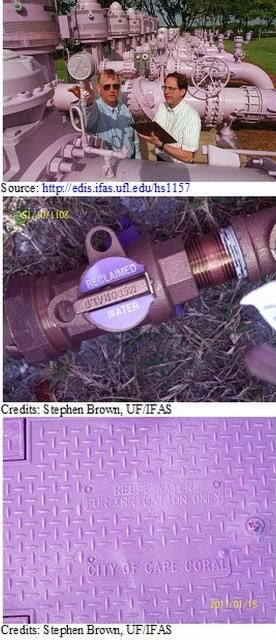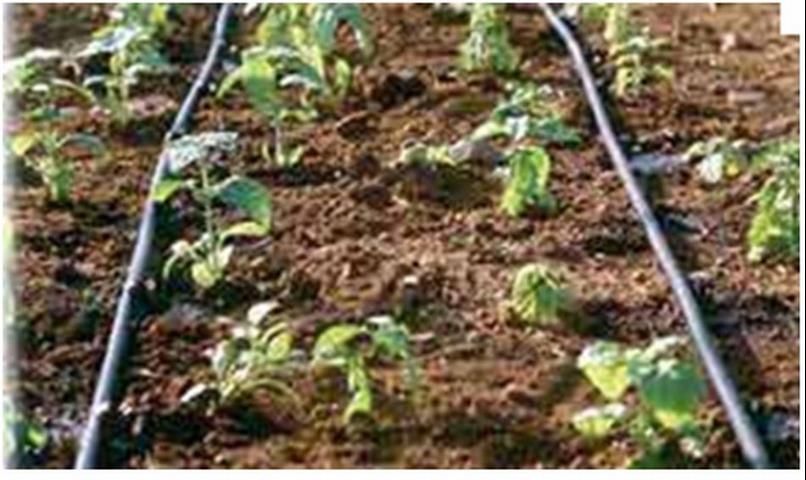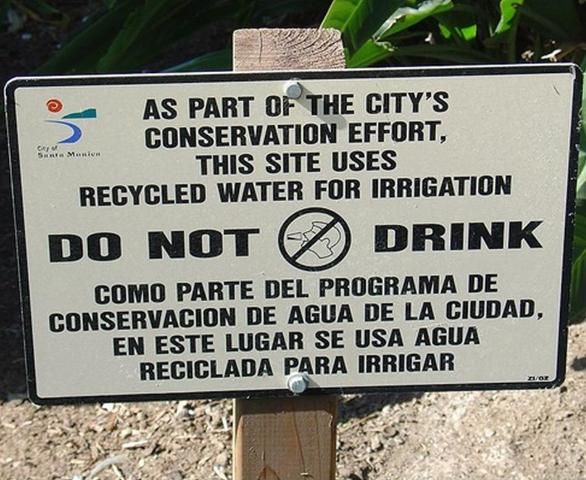This fact sheet is one of a series titled Reclaimed Water Use in the Landscape addressing various issues related to use and management of reclaimed water in urban landscapes.
As Florida's population grows, so does the demand for fresh, clean water. With increased demands for potable water (drinking-quality water) come important water management concerns. This includes protecting the environment that provides fresh water while still acquiring the volume of water we need for everyday uses, such as drinking, sanitary purposes, and landscape irrigation. The use of reclaimed water helps us preserve high quality drinking water by providing a reliable and economical alternative source of irrigation water. The following frequently asked questions address common concerns and questions about the origin and use of reclaimed water in Florida.
-
What is reclaimed water?
Reclaimed water, also known as recycled water or reuse water, is former domestic wastewater that has been disinfected and treated to remove solids and certain impurities. After treatment at a wastewater treatment plant, the cleansed water can be safely discharged into a nearby stream, wetland, or ocean, or this water source may be piped back into communities for reuse by various residential, industrial, and commercial users. The use of reclaimed water is a method to recycle water, plus it helps to conserve water resources. Though reclaimed water cannot be used for drinking, it has been used throughout the United States and the world for decades as an ideal choice for watering lawns and crops, recharging groundwater, and in industrial processes.
2. Is reclaimed water the same thing as gray water?
No. Gray water is generated from domestic activities like laundry, dishwashing, and bathing, and is recycled on-site (at its place of origin), often without any preliminary treatment. Gray water may be directly recycled within the home or garden after being collected with a separate plumbing system that contains no human waste. In contrast, reclaimed water is not recycled on-site; it is diverted from the place of origin to a wastewater treatment plant, treated, and sent back to the community for reuse.
3. How is reclaimed water produced?
Reclaimed water is produced at a wastewater treatment plant. At the treatment plant, domestic wastewater is collected from households, schools, offices, hospitals, and commercial and industrial facilities, and then undergoes several stages of treatment to prepare the water for reuse or discharge into the environment. The treatment processes are designed to ensure that reclaimed water is safe and reliable for its intended use.
The stages of treatment include the following:
- Primary treatment—the sewage is temporarily held in a basin so solid waste materials can settle to the bottom and be removed.
- Secondary treatment—after the solids are removed by primary treatment, the water left behind is further treated to remove or degrade any remaining wastes still suspended in the water.
- Tertiary treatment—a final stage that involves advanced removal of harmful chemicals and disinfection to kill disease-causing organisms.
Note that the minimum requirement for treating reclaimed water is secondary treatment in Florida, although many treatment plants use tertiary treatment. Treated, or "reclaimed," water then flows out of the wastewater treatment plant and is piped back to the community for its intended use.
4. How is reclaimed water used in the landscape?
Though reclaimed water cannot be used for drinking water in Florida, this water can be used for various non-drinking purposes, including the following:
- watering lawns and landscapes
- irrigating golf courses, parks, and highway medians
- agricultural uses, including irrigating food crops
- filling decorative fountains and ponds
- washing cars, flushing toilets, and cleaning streets
- recharging groundwater
- supplying water flow to wetlands
- industrial uses, such as those that require cooling water
5. What are the benefits of using reclaimed water?
The main benefit of using reclaimed water is that its use replaces the use of potable water. In 2009, use of reclaimed water substituted for more than 127 billion gallons of drinking water while serving to add more than 79 billion gallons back to available groundwater supplies. Using reclaimed water for non-drinking purposes extends our freshwater supplies and ensures sustainable use of a vital natural resource. Reclaimed water also reduces the cost of landscape irrigation compared to using potable water, which is generally priced higher to consumers. When used for irrigation, reclaimed water moves vertically and can recharge groundwater aquifers. Recharging our groundwater aquifers is critical because it replaces the water withdrawn to meet the needs of a rapidly growing population in Florida.
6. How is reclaimed water transmitted?
Reclaimed water is transmitted from a wastewater treatment plant to a community via a series of pipes. All reclaimed water piping, heads, valves, fixtures, etc., are required by law to be color-coded "purple" and labeled "Do not drink this water" (see Figure 1).

7. Who is responsible for the maintenance and repairs of the reclaimed water system?
In most instances, the county or city in which you reside is responsible for the maintenance and repairs of the reclaimed water transmission and distribution lines. The homeowners are responsible for any repairs or maintenance from the reclaimed water box to their irrigation system located on their private property.
8. How does reclaimed water differ from drinking water?
Reclaimed water is highly treated and disinfected but still contains some constituents at levels outside the desirable range for drinking water. Specifically, reclaimed water may have higher levels of salts, nutrients (nitrogen and phosphorus), and pathogens (e.g., bacteria and viruses). Reclaimed water has been safely used for non-drinking purposes in Florida for more than 40 years, but because of its composition, this water source should never be used for drinking or sanitary purposes.
9. Is reclaimed water safe for irrigating turf and other landscape plants?
Reclaimed water can be safely used to irrigate turf and most other landscape plants. In fact, reclaimed water often contains nutrients (nitrogen and phosphorus) that can be considered part of the fertilizer needs of the landscape. Check with your reclaimed water provider to learn about the levels of nutrients in your reclaimed water and be sure to incorporate the results into your landscape nutrient management plans.
Occasionally, reclaimed water contains elevated levels of salts that can harm sensitive landscape plants. Azaleas (Rhododendron sp.) and crape myrtles (Lagerstroemia sp.) are two common landscape plants used in Florida that are especially sensitive to high salt levels. If you live near the coast, you may also have higher than normal salt levels in your reclaimed water because of the influence of seawater. Your reclaimed water provider will have data about salt levels in your water. Check with your provider to learn about how much salt is in your reclaimed water and which landscape plants may be particularly sensitive to salts. Consult with your local UF/IFAS Extension office or with http://ufdc.ufl.edu/IR00001713/00001 to determine which landscape plants may be particularly sensitive to salts. Also see Toor and Lusk (2011), Constituents of Concern in Reclaimed Water, available at https://edis.ifas.ufl.edu/ss543.
Any potential problems associated with using reclaimed water on landscape plants can usually be avoided by irrigating only when necessary, growing salt-tolerant plant species, and minimizing the use of overhead sprinkler irrigation so that high-salt water does not contact plant foliage (Figure 2).

Credit: US Geological Survey
10. Is reclaimed water safe for irrigating my vegetable garden?
The Florida Department of Environmental Protection states that reclaimed water should NOT be directly applied to the surfaces of vegetables or other edible crops that are not peeled, cooked, or thermally processed before being consumed. This statement essentially means that as long as you peel or cook your vegetables, they may be safely consumed after being grown with reclaimed irrigation water. The statement also means that indirect application methods, such as ridge or furrow irrigation, drip irrigation or a subsurface distribution system, which preclude direct contact, are allowed for edible crops that are not peeled, skinned, cooked, or thermally processed before consumption. See Figure 2 for an example of drip irrigation in which irrigation water does not contact plant surfaces.
11. Can children use reclaimed water in water toys?
No. The Florida Department of Environmental Protection does not permit reclaimed water for human consumption. With this regulation in mind, any activity that increases a child's chance of accidentally consuming reclaimed water should be avoided.
12. Can I fill my pool or spa with reclaimed water?
No. Reclaimed water cannot be used for any purpose that might increase the chances of it being consumed. Pools and spas should be filled with potable water.
13. How is reclaimed water regulated in Florida?
Reclaimed water must meet strict standards of quality established by the Florida Department of Environmental Protection (FDEP). FDEP ensures that reclaimed water projects meet state laws and that water quality criteria are maintained. FDEP also authorizes construction and operation permits for reclaimed water systems, as well as inspects any reclaimed water that is used for indoor purposes, such as decorative fountains or toilet flushing. In administering the state's reclaimed water programs, FDEP coordinates with several other state agencies. The Florida Department of Health (FDOH) coordinates with FDEP to ensure that reclaimed water undergoes high-quality disinfection before use. Florida's Public Service Commission (PSC) authorizes reclaimed water rates paid by the user.
Throughout Florida (and the rest of the United States), reclaimed water is transmitted in purple pipes that are kept separate from the pipes that transmit drinking-quality water. Areas that use reclaimed water must also post signs to alert the public of its use (Figure 3). For example, communities that use reclaimed water may post a sign at the neighborhood entrance, and golf courses may post signs at the first and tenth tees. Advisory signs must also include the warning in English and Spanish, "Do Not Drink" and "No Tomar," respectively. Additionally, if reclaimed water is used in a fountain or stored in a pond, it must include an advisory sign that says "Do Not Swim" or "No Nadar" in Spanish.

Credit: http://en.wikipedia.org/wiki/File:Donotdrink.jpg
14. Can I overuse reclaimed water?
Nutrient (nitrogen, phosphorus) pollution may occur if the user over-irrigates the lawn because both reclaimed water that runs off on the surface and the water and nutrients that move below the root zone are lost. Maintenance of a high level of distribution uniformity in reclaimed water-irrigated sites is critical to prevent leaching and runoff of these nutrients. As long as a soil's field capacity is not exceeded when irrigating with reclaimed water, the chances of reclaimed water runoff and leaching are minimum.
15. How do I find more information about reclaimed water?
The Florida Department of Environmental Protection maintains a website on reclaimed water use and regulations for the state. You can access the site at https://floridadep.gov/water. You may also check with your city or county water services department to find out about reclaimed water in your local area. You can find detailed guidelines from the U.S. Environmental Protection Agency on reclaimed water reuse for Florida and other states at https://nepis.epa.gov/Adobe/PDF/30006MKD.pdf.
Also, see these EDIS articles for information on various aspects of reclaimed water:
(1) History and Current Status of Reclaimed Water Use in Florida. https://edis.ifas.ufl.edu/ss520
(2) What's in Reclaimed Water and Where Does It Go? https://edis.ifas.ufl.edu/ss542
(3) Constituents of Concern in Reclaimed Water. https://edis.ifas.ufl.edu/ss543
(4) Managing Salinity, Sodicity, and Specific Ions in Sites Irrigated with Reclaimed Water. https://edis.ifas.ufl.edu/ss545
(5) Understanding Landscape Irrigation Water Quality Tests. https://edis.ifas.ufl.edu/ss546


